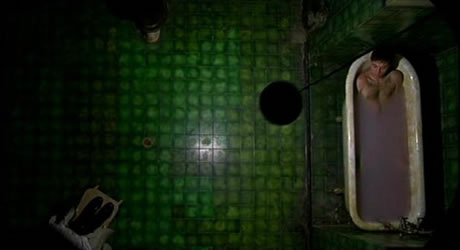Genre Smoothy
by Stephen Simons
Occasionally something comes along that so defies all categorization that it loses its rightful place of recognition or prestige.
Did anyone get the license plate of that truck?
No, I’m not talking about the XFL. But like the XFL there are many things out there that can’t decide what they are — is it football or WCW wresting, boat or car, manta ray or turtle?
Life, for those few creations that break the genre mold and actually make life better, can be an uphill battle. People who want to watch football don’t necessarily want to hear Jesse The Body Ventura’s voice, and people who want a boat might not understand why it needs wheels as well.
Pushing Daisies, can be defined in one word, “Odd,” but that hardly gives an adequate description. The show defies genre description. Netflix puts it in the categories of TV Dramedy, TV Dramas, TV Sci-Fi & Fantasy. That doesn’t even scratch the surface. Trying to label this show with pre-existing categories does it a disservice. It needs a new genre. Let me try to do it in three words: Fairy-tale/musical/murder-mystery/macabre . . . dang.
Let’s try this a different way. Because I watched episode one without any foreknowledge, I can relate accurately how the show reveals itself. For me it went something like this. Ahem . . .
Who turned the color to max on my TV, and why do I feel like I’m watching Little House on the Prairie’s opening credits? Oh, it’s because the boy and his dog are running down a hill of daisies and . . . did his dog just get flipped in the air by a truck? Well, at least the friendly old-timey narrator’s voice makes me feel safe, like I’m watching a Disney, ope, now his mom just died. But that’s ok, his touch will bring his mom back to life just like, now his neighbor is dead too? What an odd mix of morbidity and innocent joy, but now the day is done and his mother is kissing him goodni- . . . yeah, she’s dead, gone for good this time. What a messed up show.
I’m compelled to keep watching.
. . . and scene.
The show’s main character, Ned (played by the criminally underrated Lee Pace), discovered as a little boy that he could bring anything back to life with a touch. But then, if he ever touched it again, he would kill it forever (thus his mom’s first and second death). But if he brought something back to life and didn’t touch it again (killing it forever) within 60 seconds, then something else would die (in his mom’s case it was their next-door neighbor). As an adult Ned has developed an aversion to physical contact and has a meticulous shyness about him.
 So let’s take that plot device and pick a setting for it. Close your eyes and envision a world where such a story could be most appropriately played out in a week-to-week television series. Perhaps a dark, dingy city with always-wet pavement and dripping gutters?
So let’s take that plot device and pick a setting for it. Close your eyes and envision a world where such a story could be most appropriately played out in a week-to-week television series. Perhaps a dark, dingy city with always-wet pavement and dripping gutters? Or maybe a medieval fantasy village, seemingly always dusk with wet cobblestones and dripping eaves? Or maybe it works better in a dimly lit, rain forest tribe, with constantly wet paths and dripping leaves?
Unless your mind works like Tim Burton’s, you probably didn’t envision a 1950’s idyllic suburbia with the color scheme set to “extra lush” and the butterflies set to “extra-large and floaty.” But that is where creator/writer Bryan Fuller (Dead Like Me, Heroes, Hannibal) decided to set this macabre fairy tale.
And we are only beginning to genre-bend here, because adult Ned soon meets an ever-sarcastic and dismissive private detective, named Emerson Cod (Chi McBride), who sees Ned’s resurrection power and hires him to wake murder victims for the purpose of solving the mystery of their deaths — and earning a reward.
Meanwhile, Ned works at a pie shop, where his ability to touch dead fruit and bring it to a state of perfect, living ripeness means that his pies are probably as good as we imagine pie should be but never get to taste. It also means that all the fruit gets to be extra colorful, too. At “The Pie Hole,” Ned works with Olive Snook , played by Kristin Chenoweth — so yeah, there’s also singing.
So what type of show do you never want to watch on TV? Because Pushing Daisies probably contains one of those types. With so many different working mechanisms, many viewers were sure to be turned off by one or another. I just don’t think there are a lot of Disney fans out there who are also looking for a gory (with extra color!) murder mystery. And I know a lot of people who don’t like musicals.
I honestly don’t know how such a hodgepodge ever made it onto prime-time in the first place.
But I’m glad it did. Pushing Daisies was one of the most pleasant surprises I’ve had in recent years. Not very often do you get to experience something so good and original.
The fairy-tale macabre genre-bend works in Pushing Daisies. The world Fuller and Pace created feels too perfect to be grim — a place so beautiful that even death loses its stink, and possibly the only setting where a necromantic murder mystery could be played for laughs, rather than suspense.
And I haven’t even written about the best part! Remember that neighbor who died because Ned resurrected his mom? That neighbor had a daughter Ned’s age. They were playmates until their parents’ deaths tore them apart. But by a magic that only exists in fairy tales, they never forgot each other. As an adult Ned still remembers their first and only kiss (in the graveyard at their parents’ separate funerals, of course). When Emerson Cod puts Ned on the case of a suffocated girl with an unusual name, he knows exactly who it is.
He finds his childhood sweetheart, laid in her coffin, and revives her with the intent to solve her murder, but can’t bring himself to kill her again. In a rare moment of extemporaneousness he rescues her from the cemetery by setting fire to the gravediggers’ truck.

Charlotte ‘Chuck’ Charles, played by Anna Friel, is a true innocent, intellectual. With a soft and tender temerity, Chuck takes the inexplicable and bizarre in stride as though it is all she’s ever experienced or expected. Spending her entire life taking care of two agoraphobic aunts and living vicariously through books equipped her to, as she puts it, “suppose dying is as good an excuse as any to start living.”
The relationship between Ned and Chuck is as sweet as the pies he makes (sorry for that. . . I really am) and because of the special nature of their relationship, it’s also innocent.
It’s surprising how deeply tender interactions become when physical expressions are taken out of the equation. The theory that limitations stretch artistic potential finds full expression when, instead of simply writing “they embrace in a passionate kiss as the picture fades to black,” Fuller and the other writers forced themselves to create dialogue or little gestures that convey that feeling of intimacy. They do a great job.
Sadly, Pushing Daisies was cancelled after only two half-seasons. I’ll admit, in season two it seemed the writers’ well of fantastical originality already was running dry — what with the trips to Holland, Olive joining a convent, and the ever increasing near-misses of Chuck’s aunts discovering her non-dead status.
Perhaps it’s just as well.
Perhaps something so special can’t — shouldn’t — go on very long, lest it lose its specialness.
I just want people to watch it and enjoy what is there (On Amazon Prime it’s available via instant watch).
Stick through the strangeness! Its Achilles heel is also what makes Pushing Daisies such a diamond in the rough. Because murder mystery fans probably don’t want to watch a musical and musical fans probably don’t want to see talking, mutilated corpses, and people who want to see talking, mutilated corpses probably aren’t watching TV as much as they are torturing small animals in their basement.
But that’s what you get for thinking outside the box, and unlike amphibious cars, the XFL and “manta-turtle” (that’s what I’m calling it), this unlikely combination of genres actually works.








